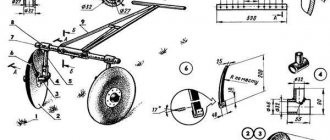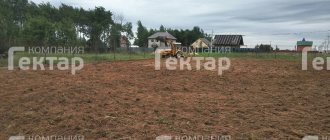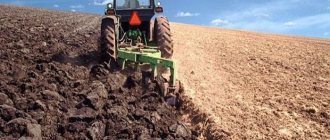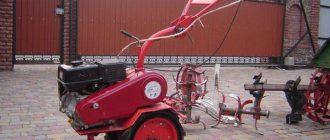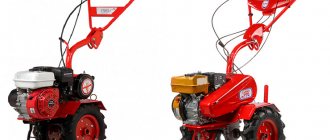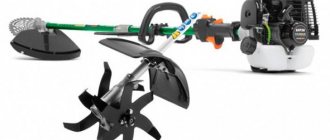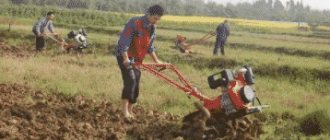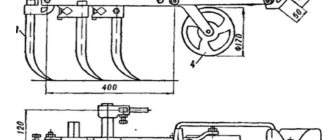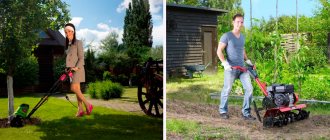Processing a plot of land involves the use of various equipment that can significantly simplify the task. Cultivators for hilling potatoes have become widespread. It significantly speeds up the process of cultivating land and increases labor productivity. There are a large number of different options for such equipment on sale, so it may be difficult to choose.
Planting potatoes with a cultivator
One of the most important agricultural crops is potatoes. It is used in many different ways, but, first of all, as a valuable food product. You can cook an incredible number of dishes from it. Potatoes are rightly called “second bread”.
But the process of planting potatoes is quite labor-intensive and time-consuming. Especially if you use shovels, hoes and hoes. But planting potatoes with a cultivator will make your life much easier.
A cultivator is a lightweight gardening machine designed to work with the soil - hilling, loosening, cutting beds. They weigh no more than 50 kg and are easy to transport. They have only two gears - one forward and one reverse, and more simplified models have only one - forward. Gasoline cultivators are quite noisy. If you like to enjoy quieter appliances, then turn your attention to electric cultivators.
Planting potatoes with a cultivator is in no way inferior to other garden tools. It performs the same functions and with the same quality, but you spend much less effort, and you will have more time to do other equally important things. And there is always a job for a shovel and a hoe in the garden.
How long does it take you to plant potatoes the usual way? One or two days? And are you terribly tired? Now you can forget about it. Planting potatoes with a cultivator on a plot of 10 acres will take only half a day.
Cultivators are sold at very affordable prices. They are compact, so transporting them is easy.
With the help of a cultivator, you can not only plant potatoes, but also dig them up. A cultivator is an excellent assistant for a gardener.
MegaOgorod.com
How to make a purchase
Hilling potatoes with a cultivator requires purchasing a high-quality model of the device.
Basically, you should focus on indicators such as engine type, as well as weight, width and depth of development. There are many models on the market with different characteristics.
The engine type can be either electric or gasoline. The first is designed to work in small areas. The second is portable and is often used on large farms.
Also, the cultivator can be divided into three: light, medium and heavy.
It is lightweight and designed for small areas; even an inexperienced gardener can handle the operation of the unit.
Cultivators in the middle category weigh more than 40 kg. They are designed for small farm areas.
Heavy equipment weighs more than 60 kg. Only an experienced farmer can handle the job. At the same time, the unit is capable of breaking up large layers of earth, which allows it to work effectively on poorly cultivated land.
Hilling potatoes with a Viking 585 cultivator
Hilling potatoes with a walk-behind tractor 2022
Loosening row spacing. Hilling potatoes.
Walk-behind tractor or shovel - which is the best way to plant potatoes?
Everyone knows how to plant potatoes, at least theoretically. It would seem that this process could be difficult - dig a hole, throw in a potato and cover it with soil, and then it will sprout on its own. No watering or special care is required when growing potatoes, just weed and hill up once. But even such an obvious process has its own wisdom, without which you risk digging up much fewer potatoes than you expected.
Preliminary work: germination of tubers and soil preparation
How to plant potatoes to achieve a great harvest? Not every experienced gardener can give an accurate answer to this question, since a good result when growing potatoes with your own hands depends on many factors: planting time, row spacing, hole depth, planting material itself, climatic conditions, etc. But about which method is more convenient and faster to plant potatoes, disputes between gardeners do not subside.
Some people plant potatoes manually in the traditional way, while others prefer to use a walk-behind tractor or a special planter. The video attached to the article shows very clearly how potatoes are planted using a conventional walk-behind tractor. Each method has its supporters and opponents; which option is more effective and easier is up to you to decide.
photo of preparing tubers for planting
Planting of potatoes begins, as a rule, when the first leaves the size of a coin appear on the birch trees, and the soil warms up to 6-8 degrees to a depth of 10 cm. Pre-sprouted and heated potato tubers can be planted in soil whose temperature is 4-5 degrees.
The soil should be slightly moist, crumble well and not stick to the shovel. Loosen the soil with a rake by 6-7 cm so that the surface is smooth and the lumps are small. Instead of digging and cultivating, it is better to prefer bayoneting with a pitchfork, lifting layers of soil and leaving them in the same place. This method requires less effort than digging and does not dry out the soil. If you plan to plant potatoes on a large area, you can use a walk-behind tractor and mill the soil to a depth of 10 cm.
In the photo, planting potatoes under a shovel
Potato tubers should be sprouted for two weeks before planting. After removing the thin white sprouts, place the potato tubers in a single layer on the floor so that light falls on them. At the end of germination (pre-planting vernalization), thick green sprouts, not necessarily large, should appear on the potatoes. Tubers planted with sprouts develop and ripen two to three weeks earlier than non-sprouted tubers. When preparing planting material, make sure that there is not a single spot on it. To increase productivity, you can dust the tubers cut lengthwise with wood ash.
Video about methods of planting potatoes
Manual method of planting potatoes
To obtain straight rows, it is recommended to first mark the furrows, precisely maintaining the distance between them, or plant along a cord. It is best to leave row spacing 70 cm wide, and from hole to hole should be approximately 26-30 cm (20 cm is enough for seed potatoes). If you make smaller row spacing, hilling and weeding will be inconvenient.
The traditional technology for planting potatoes by hand is quite simple: one person digs a hole 8-10 cm deep with a shovel, the second follows him, lowering the tuber into the hole with the sprout up and adding a handful of compost, humus or fertilizers (saltpeter, urea). When digging the next hole, the previous one is covered with earth. At the end of planting, the entire surface should be leveled with a rake, then the moisture from the soil will evaporate less.
There is a special technique for planting potatoes in areas where groundwater comes close to the surface. To do this, ridges up to 15 cm in height are formed on the soil surface, with an intermediate distance of about half a meter. Potato tubers are planted in these ridges. If the soil is insufficiently moistened, this method is contraindicated.
Using a walk-behind tractor or planter when planting potatoes
Many gardeners, in order not to bother their backs with a shovel, prefer to mechanize the process as much as possible, using a walk-behind tractor or a special planter. A planter is especially useful for potatoes if you grow potatoes using the Mittlider method: the holes are carefully cut at the same distance without disturbing the narrow beds, and the tubers are leveled on top with soil using a rake.
The picture shows potato planting with a walk-behind tractor.
Planting potatoes with a walk-behind tractor is done as follows:
- first, even planting furrows are cut, and the soil is deeply loosened;
- sprouted potato tubers are placed with their sprouts up in the furrows every 30-45 cm (if the planting material is small, then make the distance smaller);
- The furrows are closed manually with a rake or motor cultivator.
When forming furrows, try to leave a distance of 50-60 cm between them, so that during subsequent potato processing (weeding, loosening, hilling and harvesting), the wheels can pass freely without damaging the buried tubers.
Video about planting potatoes with a walk-behind tractor
Proponents of mechanical planting argue that the use of a walk-behind tractor improves the harvest, since the cultivator loosens the soil better than a regular shovel. Which planting will be more effective and give the best results, you will only find out from personal experience.
orchardo.ru
To dig or not to dig? Potato harvesting tips for dummies
For some, digging potatoes means agricultural pains and discussions about the frailty of existence.
But there are also plenty of process lovers. In fact, harvesting together can be a great family “team building” activity, as the whole family usually participates. However, in order for the harvest to please gardeners, it is necessary to remember several rules. We'll talk about them today. Potatoes "legally"
Growing potatoes is a national Belarusian tradition. But in order for everything to be “according to the law,” it is necessary not only to plant it correctly, but also to dig it up.
Tip one:
Before harvesting, mow the tops along with the weeds, leaving the above-ground part 10 cm high.
It is advisable to do this 10-14 days before the start of the “potato sacrament”. This is very important because when the tops are mown, nutrients from the aboveground part will begin to pass into the tubers. Because of this, the peel will ripen faster and the shelf life of the potatoes will increase. Also, diseases that accumulated on the tops over the summer will not penetrate the tubers. This will have a beneficial effect on the quality of crop storage.
Tip two:
After harvesting potatoes, you should not leave pulled out weeds and tops on the field. This is especially true for those who grow it every year in the same place.
Scattered waste can cause bacterial and other diseases. They can penetrate the tubers, which will seriously damage the crop next year. So, tops and weeds must be collected, dried and burned.
Tip three:
It is better to harvest potatoes in dry, warm weather, so the tubers can be ventilated and dry right on the field.
The dug up dried tubers should be spread out in bulk (in a layer of no more than half a meter) or left in bags in a dark place for several weeks. This period is called “therapeutic”. During this time, the skin of the tubers will become denser, and diseases, if any, will have time to appear. After this, you need to re-sort the potatoes, removing infected and damaged tubers.
There is no specific date after which we can confidently say it’s time to dig! The timing of harvesting depends on many factors, including the variety (early or late), when the potatoes were planted, how they were cared for throughout the summer, and weather conditions.
Some begin cleaning in July-August, others wait until the end of September. Only one thing can be said with confidence: in the summer you should dig up individual potato bushes only in order to immediately cook something from them. Such potatoes are not suitable for storage; their skin is still too thin. Even minor damage to tubers can lead to rotting and spoilage.
Most gardeners begin harvesting potatoes when the tops have turned yellow and dried out. But what to do if some of the tops are still green, some have turned yellow, and some have died? Such uneven drying indicates that neither during storage nor during planting the root crops were selected according to varieties and ripening periods. All potatoes are planted at one time and harvested after 70-100 days.
But withered tops are not always a sign of ripening. It can lie down if there is an excess of moisture or nitrogen. In this case, the upper part grows very powerful, and the root crops do not have time to fully ripen. In some varieties, the tops remain green until the end of September, although the tubers can already be dug up. Thus, the optimal time for harvesting potatoes is from the end of August to mid-September.
If in doubt, dig up a few bushes and see if the tubers are ripe. If the potatoes are large enough with a thick skin, then you can start harvesting.
Motoblock or shovel?
Digging up potatoes with a shovel is long and difficult. Fortunately, if the area is small, and there are more than enough assistants. This method is suitable for lovers of an active lifestyle. Summer, sun and a shovel - you can’t think of a better workout! Suitable mainly for owners of small plots.
But what if you need to dig up a few acres yourself? Many experienced vegetable growers have long come to the conclusion that they cannot do without a walk-behind tractor. It greatly simplifies the cleaning process, but you need to remember a few important rules:
Planting potatoes with a walk-behind tractor
Planting potatoes with a walk-behind tractor greatly simplifies the already stressful life of a summer resident.
After all, this is one of the most labor-intensive gardening operations. On a plot of 5 acres, it takes a whole day to plant potatoes under a shovel, but you can handle the equipment in a couple of hours. Despite the fact that there are many models of cultivators, the techniques for planting potatoes with a walk-behind tractor are the same for all models. The only drawback to this method is that a man must operate the cultivator. Although this may not be a minus, it is not suitable for beautiful women to run around the garden with equipment, they have more useful things to do, for example, designing a summer cottage or preparing meat according to a delicious kebab recipe. And in this article we will tell you how to plant potatoes with a walk-behind tractor. To do this, in addition to equipment, you need to purchase additional attachments in the store: iron wheels (lugs), wheel extensions, single-row or double-row hiller, universal hitch, cutters. For each model, the equipment is slightly different, so check with the sellers on site what is for what, so as not to travel and change later. Hitches are also different, we advise you to buy this one first, and then select everything else.
Harvesting
A walk-behind tractor is convenient not only for planting potatoes, but also for harvesting them. This is done in early autumn (September-October) in dry weather. To do this, an additional attachment is installed on the unit - a plower. Sometimes it is called a “potato digger.”
You can see how the harvest is harvested using a plower in this video
But you don't have to use it. It is enough to use a single-row hiller. He will lift the ground, and the potatoes will lie on the edge of the bed. All that remains is to go around the area and collect the ripe crop.
To avoid potato germination, after harvesting it should be placed in a dark, cool place. There it should lie for 2-3 weeks. Afterwards, the potatoes need to be sorted by size. And only after that send it to the cellar.
CULTIVATING THE LAND WITH A MOTOR-BLOCK
Before planting potatoes with a walk-behind tractor, the soil must be cultivated so that it is loose and soft. Previously, it was dug up with a shovel, which took a lot of time and effort. Now, having attached cutters to the equipment instead of wheels, we cultivate it quickly and efficiently.
We use a Neva-MB2 walk-behind tractor, a reliable and unpretentious piece of equipment that has been serving us well for several years. With its help we carry out all garden work. Cultivation is carried out at 2nd speed. We start work from the edge of the site. Having reached its end, we cultivate 2 meters of land perpendicular to the furrows; this will be the place to turn around. On the other side of the site we do the same.
Now we cultivate the area along the beds.
The cutters leave small depressions in the soil. In order for the garden to be processed efficiently, when driving in the opposite direction, you need to use one cutter to follow the trail left by the other cutter. Then the land will be cultivated to the depth of a spade, which is optimal for planting potatoes. There are times when someone asks mercenaries to plow the garden with a cultivator, but in order to do it faster, they do not put the cutter in the furrow left by another cutter. This reduces the depth of cultivation and makes it difficult to plant potatoes in such a garden.
Some summer residents cultivate their garden in a circle, starting from the edge, reaching in a spiral to the center of the plot. The disadvantage of this method is that the soil must then be leveled with a rake, which also requires some effort.
When you cultivate the area along the beds, the plowing turns out to be even; you need to use a rake to level the ground only in the places where the equipment turns.
Homemade equipment for planting and hilling potatoes, diagrams
The range of homemade equipment for processing potatoes is huge. And although there are many devices on sale that can be used to plant and hill up potatoes, craftsmen are constantly creating new devices to make the work easier and faster during the sowing season.
The simplest device is a marker. Its purpose is to mark the ridges in such a way as to make the plantings even and suitable for subsequent processing with motor cultivators. For homemade markers, the distance between the cones coincides with the track dimensions of the existing equipment that will subsequently be used to process the plantings. Homemade markers can be simple or complex, made of wood or metal. The main thing here is how far apart the cones that punch the holes are located.
PLANTING POTATOES WITH A MOTORBLOCK USING A DOUBLE-ROW HILLER
So, we have prepared the garden, now you can start planting potatoes with a walk-behind tractor. To do this, instead of cutters, we will install lugs, having first put iron extensions on them.
On the Neva-MB2 it is necessary to remove the wings before doing this. We remove the central stop from the walk-behind tractor and hang the hitch in its place. Everything is done very simply, just insert metal pins into the holes. We attach a two-row hiller to the hitch. Before this, we make the distance between the hillers equal to 65 cm, this will be the width between the beds.
Let's mark the garden with a special marker that we will make with our own hands.
To do this, screw short pegs to a long wooden handle with self-tapping screws so that they resemble a rake. In total you need 3 pegs, the distance between them will also be 65 cm. Take a marker and draw stripes with it. To maintain the distance, you need to let the outermost peg follow an already drawn line.
Let's adjust the cultivator to the marking and press the first speed to cut the furrows.
Using the hitch, you can change the position of the hiller, thereby increasing the depth of processing. To do this, you need to tighten the adjustment knob. Having reached the end of the garden, we turn around and go in the opposite direction. You can put one hiller into an already made furrow, or you can, if the soil is soft, follow the marked lines. Having cut as many furrows as necessary, we begin planting potatoes. We throw the pre-sprouted tubers into the ridge, maintaining a distance of 35-40 cm between them.
Before this, it would be good to treat them with a special composition against the Colorado potato beetle, it is called Prestige. Looking ahead, let's say that the method works, the beetle is not on the leaves for a long time. But when the drug stops working, a few larvae still appear.
Having planted the potatoes in the furrows, we will begin to fill them up. Before this, on the hiller we will increase the working width of the wings, spreading the blades as far as possible, if the design of the equipment allows this. Let’s place the equipment opposite the ridges and, at first speed, cover the potatoes with earth.
This operation requires some skill, since you have to control two ridges. To make it easier, you can remove one hiller and place the second in the center. Instead of lugs, we will install rubber wheels. Let's direct the cultivator in the center of the ridge and fill up the potatoes in the same way, bed by bed. If you do not have a two-row hiller, all the work of planting potatoes with a walk-behind tractor can be done in a single row. But for this, the width between the ridges must be made equal to 70 cm. This size is optimal. At the end, if there are any unevenness, we will correct the beds with a regular hoe.
Watch the video
Inter-row cultivator KRN 5.6
The mounted cultivator for inter-row tillage KRN-5.6 is designed for inter-row tillage of 8-row crops of corn, sunflower, castor bean and other row crops, sown with row spacing of 600, 700, 900 mm, with complete cutting of weeds, high-quality loosening of the soil with simultaneous application of bulk mineral fertilizers.
Photo of inter-row cultivator KRN-5.6
Provides high-quality loosening of the soil between rows to a given depth with the destruction of weeds, a parallelogram suspension of sections of working parts ensures copying of the soil topography, atmospheric pressure tires and rubber-coated rollers of the cultivator ensure their self-cleaning of adhering dirt, there is an option to use the cultivator for continuous cultivation using single-sided flat-cutting tines, the presence of a transport device allows transportation on public roads with a clearance of 2.5 m. Basic equipment: single-sided flat-cutting paws (right and left), pointed paws. The KPE-3.8 cultivator has a different design.
Technical features of KRN 5.6
- The sections are fastened to the frame beam using two clamps and a dovetail bracket, which increases the reliability of fastening and eliminates changes in row spacing during operation. (An analogue - made with an L-shaped clamp and plate, which does not guarantee constant row spacing).
- Ceramic-metal bushings with lubricant embedded in them are pressed into the cages and an additional oiler is installed. (An analogue - cast iron bushings without an oil can are pressed into the holder).
- Double protection against dust and dirt is installed (dust boot and rubber sealing ring). (Analogue – no protection).
- The cages contain a machined axle with traction plates attached to it on both sides. (An analogue - a U-shaped circle is installed in the holders without processing, which leads to displacement of the section during operation).
- A wide copy wheel is installed, which allows for better soil copying regardless of humidity. (Analogue – a narrow wheel is installed).
- Section design
- The working bodies are mounted on a rectangular pipe 60*40mm, which guarantees the reliability of the fastening and the quality of the technological process. (Analogue – the working parts are fixed on a 25mm square).
- semi-mounted reversible plow for highest productivity with hydraulic or stepwise adjustment of the working width of each body from 30 to 55 cm
- variants from five to nine furrows for tractors with power from 92 kW (125 hp)
- distance between bodies 100 or 120 cm, frame height 80 cm
- Comfortable, tool-free skimmer adjustment
- The support wheel moves within the plow frame (from six-furrow plows) for optimal plowing at the edge of the field and plowing near fences or other obstacles
- also available with continuous mechanical or hydraulic overload protection system
- Also available in Onland version for plowing, both in-furrow and out-of-furrow.
To work in small areas, it is better to choose another unit, for example, a walk-behind tractor.
Technical characteristics of the mounted cultivator KRN 5.6
| Working width, m | 5.6 |
| Productivity, ha/h (main time) | 5,6 |
| Processing depth, cm | 6 – 10 |
| Operating speed, km/h | 10 |
| Overall dimensions in working position, mm: length, width, height | 1590/6500/1615 |
| Weight, kg | 1300 |
| Aggregation method | mounted |
| Overall dimensions in transport position, mm: length, width, height | 12280/2240/1725 |
| Compatible with traction class tractors | 1,4 |
Video review of the KRN 5.6 cultivator
PLANTING POTATOES WITH A MOTOR-BLOCK USING A PLOW
You can plant potatoes using a plow, which is used to plow the garden before winter, turning the soil over. We will talk about this method using the Favorit walk-behind tractor as an example. We attach the plow and lugs to it.
There is no need to mark the garden with lines. First, we cut one furrow with a plow. The peculiarity of this method is that you need to immediately throw the potatoes into the garden bed. Let's throw in some potatoes, turn the cultivator around, put the outer wheel in the garden bed, and fill it up with soil from the newly cut furrow. There is nothing to worry about if the lug goes over the potatoes; the potatoes are not afraid of this. So we plant bed after bed at the first speed of the walk-behind tractor. This method of planting potatoes with a walk-behind tractor seems to us more convenient, since we immediately cut one bed and fill another, and the beds turn out smoother due to the fact that the wheel follows the cut furrow. Planting potatoes with a walk-behind tractor is completed.
Watch the video
Steam cultivators CROP
This type of cultivator is intended for continuous tillage of the soil. As a rule, it is used for pre-sowing activities, for cultivating fallows and loosening stubble waste from the previous sowing.
Heavy duty model
This cultivator is a heavy one, but this does not slow down the work being done. The design of the racks with which the unit is equipped and the staggered arrangement contribute to the unhindered automatic removal of weeds. The distance between the posts is specially increased, so it is used in fields with dense soil.
The hydraulic adjustment of the tine, disc and rollers in this steam cultivator greatly facilitates control and gives a solid functional area.
This pre-sowing stubble unit also follows the contours of the cultivated terrain thanks to the tandem design of the support wheels.
An indispensable assistant
The CROP pre-sowing cultivator is used after harrowing to eliminate the emergence of harmful grasses and cultivate fallows. During the work, he creates a loosened earthen layer for future planting of seeds.
Free adjustment of the cultivator elements makes it possible to crumble, loosen and partially mix the soil. With continuous tillage, the lower layers will not be brought to the surface.
Thanks to its balanced assembly, the CROP pre-sowing fallow stubble cultivator prepares the area in just one pass, guaranteeing good contact with the soil during continuous tillage.
Plant residues from the field must be removed before replanting. Therefore, the stubble cultivator covers the stubble efficiently and, if necessary, can replace plowing with plowing.
The steam cultivator not only performs continuous tillage of the soil, but is also applicable for other tasks. This makes such a cultivator a universal tool in farming.
HITTING POTATOES WITH A MOTOR-BLOCK
Some time after planting, the potatoes will sprout and grow.
During this period, it needs to be hilled up, that is, added to the soil tubers. Again we will use a two-row hiller. As written earlier, we will install lugs on the cultivator, increase the working width as much as possible and run the walk-behind tractor at first speed between the beds. Since the distance between the beds and the hillers is the same, the wheels run exactly along the beds without touching the potato stems, and the hiller rolls the soil to the tubers. We will plant the entire garden in this way. If you use a single-row hiller, you need to put the equipment on rubber wheels and run it between the ridges. A width of 70 cm is enough so as not to touch the potato bushes. Important note: you need to hill up potatoes with a walk-behind tractor after rain, when the soil dries out and becomes slightly moist. The benefits of this operation are enormous: the potatoes gain access to air, weeds are removed and soil is added to the tubers.
Types of hillers
In the process of hilling potatoes, the need arises when the vegetable has grown at least 10 cm from the soil surface.
To hill potatoes, you need to use a hiller, which can be of several types: disk, Dutch type, with a variable working width. It was the hiller with the ability to adjust the working width that deserved more trust. Although working with it requires more effort, the possibility of adjustment allows you to expand the scope of activity of a walk-behind tractor with such a hiller.
Disc hillers promise careful planting of potatoes and are easy to use, but they are more expensive than others.
The Dutch-type hiller is more economical, cheaper, and the recesses obtained with its help keep their shape well.
Experienced agronomists recommend purchasing walk-behind tractors that run on diesel. They have more power and the fuel is a little cheaper.
DIGGING POTATOES WITH A MOTOR BLOCK
Thanks to all our efforts, by autumn the potatoes had grown and the tops had dried. So it's time to clean it up. This is usually done at the end of August, beginning of September. The main thing is that the weather is dry, otherwise the tubers will be damp and dirty, and they will have to be cleaned of soil before storage.
Before harvesting, the remaining tops must be mowed with a scythe or trimmer and removed so that they do not get in the way underfoot. To dig potatoes with a walk-behind tractor, you can buy special attachments - a plower. But we can do without it; this operation can be completed with a single-row hiller. We put it on a walk-behind tractor, attach the lugs, install the equipment in the middle of the bed and plow out the potatoes at first speed. The hiller cuts the soil and places the potatoes along the edges of the bed. First, we will plow the ridges one by one, collect the harvest, then we will plow the remaining ones.
Let's put the potatoes in a dark shed so that they don't turn green from the light. In two weeks, when it has rested, we will sort it into small and large ones and put it in the cellar for storage. In a dry, dark and cool place, potatoes will last until the next harvest.
Modern technology should make the life of a gardener easier. In this example, we showed how you can plant, hill up and dig potatoes with a walk-behind tractor.
What else to read:
www.stroimzanovo.ru
Advantages of working with technology
The equipment in question is designed in such a way that it can be used without prior preparation. Digging potatoes with a motor cultivator is characterized by the following advantages:
- High labor efficiency.
- Various types of soil can be cultivated.
- The soil is mixed and weeds are removed.
The only disadvantage is the high cost of cultivators, as well as the need for fuel and periodic maintenance. For large areas, purchase a potato planter, which greatly simplifies the procedure.
How to plant potatoes with a walk-behind tractor?
Few summer residents do not allocate space on their plot for planting potatoes. The role of potatoes in our daily diet can hardly be overestimated. But planting and harvesting potatoes gives us all a lot of trouble.
To facilitate the process of planting potatoes, there are special devices. The most common of them is the walk-behind tractor. But how to plant potatoes with a walk-behind tractor? This question interests many summer residents, since it is quite problematic to find instructions for working with a walk-behind tractor. After all, when purchasing a walk-behind tractor, only instructions for operating its engine are attached, but there are no rules for working with attachments at all, so you have to deal with this miracle of technology yourself.
A separate article has already been written on how to properly plant potatoes and care for them, which I highly recommend you read. Today we will look at another exciting problem that was mentioned above - how to plant potatoes with a walk-behind tractor, which makes our work much easier. So…
Planting potatoes with a walk-behind tractor begins with making furrows. First, the first furrow is made, and we try to go through it as evenly as possible. After this, the walk-behind tractor wheel is placed at the edge of the first furrow and then the second one is made just as smoothly. All other furrows are made in the same way. The distance between individual furrows with this method is the most optimal - approximately 60 cm.
If necessary, fertilizers are applied to the furrows before planting. Then the potato seeds are evenly distributed over all furrows, after which you can use a walk-behind tractor to fill the potatoes in the furrows. To do this, the walk-behind tractor must be positioned in such a way that one of its wheels runs over the potatoes. This is the only way to get even and evenly filled rows.
It is recommended to use metal wheels at the stage of forming furrows, and rubber wheels when filling potatoes. This is necessary in order not to damage the newly planted potatoes in the furrows.
The walk-behind tractor is a great success among summer residents, because planting potatoes with a walk-behind tractor is much faster and easier. Planting potatoes with a walk-behind tractor in large areas is especially widespread. In general, walk-behind tractors are not uncommon nowadays and they are widely used in household farming. Walk-behind tractors greatly facilitate soil cultivation and perform many other tasks through the use of various attachments. Very often, “motor block” is confused with another term – “motor cultivator”. The main function of motorized cultivators is cultivation, i.e. loosening the surface soil layer without turning the layer over. Walk-behind tractors are more versatile and can use special mounted or trailed implements. Using a walk-behind tractor, you can plow the ground, crush large blocks after plowing, remove weeds, loosen the soil, mix applied fertilizers with the soil, clear the area of snow, transport cargo, etc.
How to make a device for hilling with your own hands?
If you don’t want to spend money, then you can make a universal manual hiller that will serve the farm for many years. It can also be used for digging potatoes. The work will require a minimum of materials: a stainless steel pipe, several metal plates curved towards the middle, and a welding machine. The assembly order is as follows:
- A piece 1 m long is cut from a pipe with a diameter of 25 mm. It will play the role of a stand, to the bottom of which you will need to weld a fastener that holds the working part of the potato digger. It is best for this element to have the shape of a flange to which the knives will be attached using threaded connections through special holes. It is necessary to weld a piece of pipe perpendicularly on top, which will act as a rod;
- For better support, the ends of the rods should be bent at a right angle. A grip is welded in the middle of the rack, which the farmer's assistant will pull on. To use it with a walk-behind tractor, you will need to make a mount on the grip;
- It is necessary to weld a knife in the shape of a faceted triangle onto the metal plates. To create a knife, carbon steel with a thickness of at least 4 mm must be used;
- Finally, the plate with the knife should be secured to the bottom of the rack.
After manufacturing, it will be necessary to process the seams remaining as a result of welding. To do this, you can use a grinder. The described option involves making a simple hiller with which you can dig potatoes. No more than three hours will be spent on the work, and as a result you will receive a reliable tool that processes the soil efficiently.
Stages of soil preparation and planting potatoes under a walk-behind tractor: working with various attachments
plow the soil with a walk-behind tractor using the appropriate attachment - a plow (cutter) . The main thing is to correctly adjust the appropriate attachments before plowing. You need to start setting up by gripping the plow (two bolts on the universal hitch). Next, the angle of attack (plough depth) is adjusted by rotating the handle on the hitch. With the correct settings, the walk-behind tractor will plow smoothly and you won’t need to put a lot of effort into holding and guiding it along the furrows. According to experienced gardeners, after such plowing there is often no need for harrowing.
Harrowing must be done so that potato tubers can sprout without hindrance after plowing. This process consists of loosening the top layer of soil so that the seedlings receive enough moisture and oxygen. Using a special attachment on the walk-behind tractor, you will perform harrowing much faster and more efficiently than using conventional hand-held agricultural implements (harrow, rake).
Planting potatoes with a walk-behind tractor can be done using a potato planter-trailer or a mounted potato planter. The operating principle of a potato planter for a walk-behind tractor is that it has a special plow that breaks parallel, uniform furrows of a given depth and places potatoes of different sizes at equal distances into the ground. Immediately after this, the potatoes are covered with earth using special hillers.
A method in which the application of fertilizers is combined with planting potatoes using a device for applying fertilizer together with a mounted potato planter has become widespread.
After the potatoes have sprouted and gained sufficient growth, they need to be hilled . There is also a special attachment for this - one - a three-row hiller.
Device for harvesting potatoes
You can read about how to properly harvest and store potatoes by following the link. Potato tops are mowed using a walk-behind mower. Then it is raked into piles with the same walk-behind tractor and removed from the site. Craftsmen have come up with a special attachment for walk-behind tractors: a “shelf” of metal rods is attached above the single-arm plow. As the walk-behind tractor moves, clods of earth fall between the rods, and the potatoes move further and fall onto the ground from above. The harvested potatoes are then placed in a trailer and transported to the storage location.
In conclusion, we can conclude that the difference between a walk-behind tractor and a cultivator is that a walk-behind tractor is a multifunctional device that can not only loosen the soil, but also almost completely mechanize human work and greatly simplify it. At the same time, the walk-behind tractor is very easy to operate. The main thing is to choose correctly.
Finally, I suggest you watch a video about how to plant potatoes under a walk-behind tractor.
Types and best models of potato diggers
Hiller cultivator for potatoes is classified according to a large number of different characteristics. Conventionally, several groups are distinguished:
- According to their purpose, steam and row-crop devices are distinguished. The first type is used for cultivating the land and planting crops, the second for loosening and weeding. The difference lies in the type of attachments installed and some other points.
- When choosing equipment, a gardener must pay attention to the type of working tool being installed. Disc ones are designed for cultivating soft soil, while lancet ones are used for applying fertilizer. Ploughshares are required when preparing a plot of land for planting, and milling machines for loosening dense soil.
- According to the type of traction, electric, gasoline and diesel cultivators are distinguished.
A potato digger for a walk-behind tractor is also classified by weight and type of material used in manufacturing.
Factory
A cultivator in Moscow can be purchased at different prices. When choosing, the following are taken into account:
- Gasoline engines are reliable; electric traction is not suitable for use when cultivating large areas of land. Diesel engines are installed less frequently due to lower reliability and high cost.
- The depth of immersion depends on the type of attachments installed, as well as the power of the engine.
A large number of different companies are involved in the production of such equipment; reliability and service life depend on the popularity of the brand.
Homemade
To save money, you can create a cultivator with your own hands. The classification is carried out as follows:
- Intended use: for planting or loosening.
- According to the degree of mechanization.
In some cases, attachments are created, in others, a full-fledged walk-behind tractor.
Electric cultivator for the garden: price, features of choice
The wide range of electric cultivator models on the market are varied in their technical characteristics. The first thing every buyer does is outline the range of tasks assigned to him and the equipment.
Having a small plot or purchasing a unit for caring for small flower beds, you should choose a low-power electric cultivator. Firstly, low power will be sufficient, and secondly, it will save energy consumption and, accordingly, finances.
Electric mini-cultivator Hyundai T1500E with a power of 1500 W
When choosing, there is no point in paying attention to electric cultivators with a large set of cutters if you are interested in lightness and maneuverability, and not powerful loosening. It is also necessary to remember about the type of soil on the site, and take this into account when choosing an electric cultivator for your dacha. For example, not every electric cultivator can cultivate clay soil. You can buy a device for your dacha of any power, weight and dimensions, taking into account all of the above.
And of course, you need to purchase goods from trusted places, demand quality certificates from sellers, check the availability of all necessary documents and trust trusted brands.
Electric cultivator Patriot Tesla
Prices for electric cultivators for dachas range from 4-5 thousand rubles to tens of thousands. This directly depends on the technical characteristics, manufacturing country and brand. If you decide to buy an inexpensive electric cultivator for your dacha, you need to seriously weigh the pros and cons.
Review of prices for some models of electric cultivators:
| Manufacturer | Model | Power, W | Weight, kg | price, rub. |
| Champion | EC750 | 750 | 7,2 | 5000 |
| Gardena | EN 600/20 | 600 | 6,5 | 8000 |
| Hope | Hope 01 | 1100 | 45 | 12600 |
| Loplosh | Loplosh 2000 | 2000 | 38 | 20100 |
| Tarpan | EK-03 | 2200 | 45 | 23000 |
Inter-row milling cutter
It is necessary for eliminating weeds, effective for loosening the soil and using material for fertilizer. For inter-row processing, cutters are used for crops such as cabbage and onions, beets and carrots, tomatoes, and not only potatoes. In the soil treated with a mill, nutrient compounds are stored longer, which contribute to increased productivity. As a result, gardeners have to use less herbicides.
Using a cutter, you need to count on sectional processing. The cutting width will vary depending on the cutter model. On average, the range ranges from 22 cm to hundreds.
